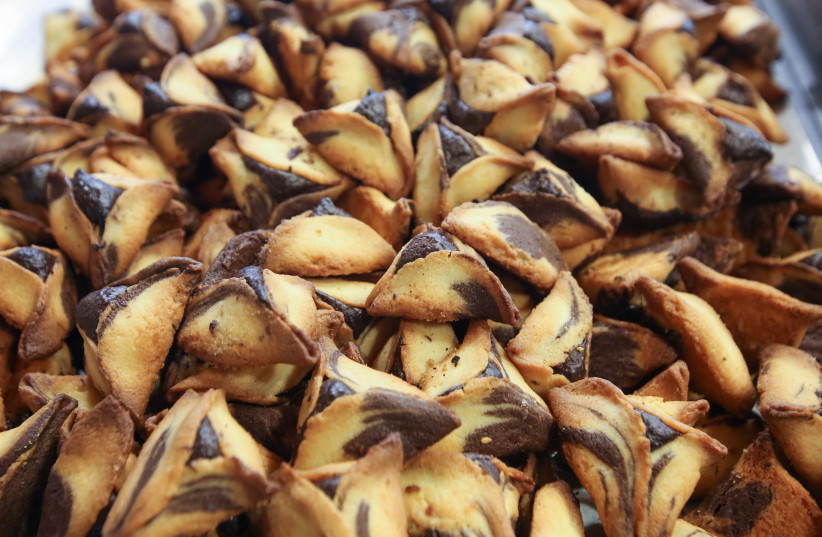My mom’s hamantaschen recipe carries the memories that she is losing - opinion
As an adult with young kids of my own, I get it, but as a child, it didn’t occur to me that my mother had already spent hours setting everything up.
(JTA) — My mother always loved to cook and bake, but I was never welcome in the kitchen. Not every night before dinner, not before Shabbat when she made challah every week, and not in the leadup to Hanukkah and Passover, when her latke and seder preparations were underway.
The big exception was just before Purim, when she would ceremoniously invite me into the kitchen to help her fill and pinch the triangle-shaped cookies that are a trademark of the holiday.
As an adult with young kids of my own, I get it, but as a child, it didn’t occur to me that my mother had already spent hours setting everything up.
All I had to do was walk into the kitchen, take a round cup, place it on the rolled-out dough, peel away a circle, scoop jelly from a bowl that she had laid out for me, and pinch the corners of the cookie and put them on the tray. I felt like I was really baking hamantaschen.
The cookies of semi-mysterious origin are core to helping the eater celebrate the Jewish holiday of Purim — a tale told of a villain, Haman, who wanted to destroy the Jewish people in the ancient kingdom of Persia. The cookie is the ultimate revenge: Its Yiddish name means “Haman’s ears,” so in the end it’s us, the Jews, who end up consuming our oppressor, and not the other way around.
My mother talked to me about this meaning — until she began to lose the ability to speak at all.
Two years ago, she was diagnosed with primary progressive aphasia, a type of dementia where she struggles to recall words, has short-term memory loss and confuses dates and times. Eventually, she will lose her ability to speak or understand words.
As with so much in Jewish life, her decline is linked in my family’s memory to the Jewish calendar. We started to notice changes several years ago when she arrived in New York City for a celebration of Rosh Hashanah and could not put into words what she had brought with her. (It was her special apple cake, my favorite.) Then, she set the table with challah and candles, as she would to get ready for Shabbat — but it was Thursday. And it was when I started to prepare for Purim in 2021 that I realized it had been an entire year since my mother had sent me anything by text or email.
The last message I’d gotten was a document I needed for our first pandemic Purim, when my son was 3 and we’d only just started sheltering in place in our apartment. Titled “Mommy’s Hamantaschen Recipe,” the document allowed my mother and my son to bake together via FaceTime. Even though she was on the phone, my mother was laughing and present.
A year later
A year later, she could not be. But as a Jewish educator, I was tasked with the job of creating virtual programming for my community, to sustain us, to keep us together even though we were apart. Like many Jewish communities in that moment, we as a community decided to bake hamantaschen on Zoom together, everyone in their own home. I sent “Mommy’s Hamantaschen Recipe” to 500 households through the Jewish Community Project of Lower Manhattan.
This week, as I dug out the supplies to make hamantaschen with my own children in our new home outside Philadelphia, I opened the recipe file again. And I remembered: I had dropped the “Mommy’s” from the title — making the recipe my own.
My mom is still alive, thank goodness in relatively good health, and I’m thankful every day for that and for my dad, who is her full-time caregiver. I try to focus on the fact that she is still here, and not to dwell on the parts of her that are missing. And so as her absolutely delicious recipe gets used once more in countless Jewish homes this year, I am thinking about all of the children who are getting the experience that was a highlight of my childhood: forming hamantaschen that somehow never fall apart, using my mother’s recipe.
I know that when I tell my mother about her recipe’s reach, she will feel, if only for the briefest of moments, the pride and joy that I once felt taking up my post at the end of her hamantaschen assembly line. And I will take comfort, yet again, in the fact that the Jewish calendar creates opportunities to mark the passage of time in ways that can outlast any of us, making memories when we cannot make new ones of our own.
Jerusalem Post Store
`; document.getElementById("linkPremium").innerHTML = cont; var divWithLink = document.getElementById("premium-link"); if (divWithLink !== null && divWithLink !== 'undefined') { divWithLink.style.border = "solid 1px #cb0f3e"; divWithLink.style.textAlign = "center"; divWithLink.style.marginBottom = "15px"; divWithLink.style.marginTop = "15px"; divWithLink.style.width = "100%"; divWithLink.style.backgroundColor = "#122952"; divWithLink.style.color = "#ffffff"; divWithLink.style.lineHeight = "1.5"; } } (function (v, i) { });

